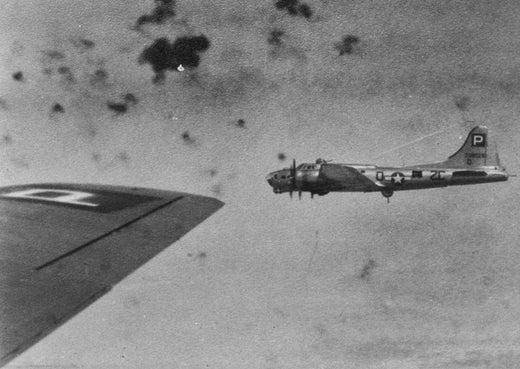This Fine Art Print by Artist Craig Tinder depicts the 24 December 1944 mission of the B-17G Flying Fortress "High Tailed Lady" of the 487th Bombardment Group en route to the Luftwaffe airfield in Babenhausen, Germany, and includes an authentic relic from a B-17 Flying Fortress.
Details about the RELIC:
This B-17G Flying Fortress wing skin originated from B-17G-95-DL 44-83872 (BuNo. 77235), known as "Texas Raiders" during a significant wing spar restoration in 2001. This particular artifact originated from the outer wing segment of the port wing. The artist was a Loadmaster and restorer of this aircraft and personally acquired this material during these restoration efforts.
 B-17G-95-DL 44-83872 aluminum panels removed during restoration process
B-17G-95-DL 44-83872 aluminum panels removed during restoration process
 B-17 Flying Fortress fragment mounted for "High Tailed Lady" artwork
B-17 Flying Fortress fragment mounted for "High Tailed Lady" artwork
The Story Behind the Print:
On 24 December 1944, during the final days of the Battle of the Bulge, B-17G Flying Fortresses of the 487th Bombardment Group took to the skies as part of Mission No. 760, targeting strategic sites in Babenhausen, Germany. This mission was vital in disrupting German supply lines and diminishing their capacity to continue the fierce counteroffensive. Leading the 8th Air Force, the Flying Fortresses were met with heavy resistance from the Luftwaffe, specifically Focke-Wulf Fw 190 A-8s of IV.(Sturm)/JG 3, a renowned German fighter squadron known for their aggressive aerial tactics against Allied bombers.
 One of the few known photos of "High Tailed Lady"
One of the few known photos of "High Tailed Lady"
Near Liège, Belgium, the Luftwaffe launched a coordinated attack on the B-17 formations, leading to one of the most intense aerial engagements of the mission. The IV.(Sturm)/JG 3 pilots, trained in specialized bomber interception, aimed to inflict as much damage as possible, claiming 10 B-17 Flying Fortresses that day. Despite this aggressive assault, many B-17s fought bravely to complete their mission, including High Tailed Lady (serial 43-38028), which managed to evade destruction and continue flying.
High Tailed Lady, with its durable construction and the determination of its crew, survived the perilous attack and went on to complete its bombing run successfully. This aircraft, like many others, played a crucial role in maintaining the offensive pressure on Germany during this critical period. Though the Luftwaffe made significant claims, the resilience of the 8th Air Force allowed them to continue their relentless campaign in the final stages of World War II. High Tailed Lady's survival stands as a testament to the strength of the B-17G and the bravery of the aircrews who flew these dangerous missions.
Learn more about the Tactics, Goals, and Controversies of the Strategic Bombing Campaign Over Europe. Click Here
To purchase or see similar items, visit here.
Commissioned by Museums, Treasured by Collectors





Share:
Warbirds Over The Beach Airshow - 2021
Panoramic Prints Have Arrived!